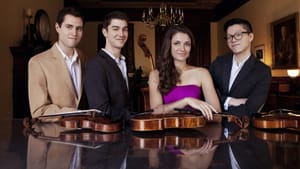Stay in the Loop
BSR publishes on a weekly schedule, with an email newsletter every Wednesday and Thursday morning. There’s no paywall, and subscribing is always free.
Youth will be served
The Dover Quartet at the Curtis Institute of Music

There’s nothing like coming home, as Joel Link, the first violinist of the Dover Quartet, pointed out before the start of the ensemble’s superb Curtis Institute recital. Dover was formed at Curtis in 2008, returned as the school’s quartet-in-residence in 2013 and 2014, and now, headquartered at Northwestern University, has been steadily reaping awards. It’s as good a younger group as you’ll find anywhere -- and maybe it’s time to take off the “younger” label, too.
As complex as its composer
The program began with a work the Dover just recorded: Mozart’s Quartet in F Major, K. 590. It was composed for King Frederick William II of Prussia, an amateur cellist. Remembering Beethoven's patron Count Rasumovsky and some other titled lights, you have to wonder at the musical cultivation of these Enlightened Despots. Of course, a taste for music doesn't guarantee other qualities. Richard Nixon played the piano. Frederick William’s predecessor, Frederick the Great, was a musician; some of his own compositions are still performed.
Mozart’s K. 590 was Mozart's last quartet. It shows him having fully assimilated the influence of Haydn (who was still active) but also putting his inimitable stamp on the form Haydn created. A simple triad in the first violin gets the piece going, and it provides the structural underpinning for the opening Allegro moderato, which goes through a considerable range of mood but remains—like the work as a whole—predominantly sunny.
Sunny is not simple, though; we hear the full play of a mature mind of sublime grace and elegance. No one comes closer to perfection than Mozart, or achieves it more often, and in that sense his tragically short life of 35 years was fully complete. What, though, if he had lived to hear Haydn’s last quartets -- or, had he only reached 50, Beethoven’s Rasumovsky Quartets? Then again, to flip the question, what might Haydn and Beethoven have learned had they heard Mozart’s next 20 or so quartets? But we should be grateful for what we have, and with the Dover’s fine, detailed, and beautifully integrated performance, I certainly was.
Bringing home the war
Benjamin Britten’s Second Quartet was featured earlier this month by the Escher Quartet in the Philadelphia Chamber Music Society’s series. But this rarely performed work was worth hearing with a second group, and the Dover Quartet clearly regards it as a special cause. Two particular circumstances shaped the Second Quartet, composed in 1945: The 250th anniversary of the death of England’s signature composer, Henry Purcell, and the end of World War II. Purcell’s anniversary had already prompted what remains Britten’s most popular and virtuosic work, The Young Person’s Guide to the Orchestra, which was based on a Purcell tune. Britten’s homage to Purcell was extended in the long chaconne that concludes the Second Quartet, a Baroque-era form whose specific reference to Purcell was underscored by Britten’s reference to it in the score as a “Chacony,” the earlier composer’s own spelling of the form.
The influence of the war’s end on Britten was not merely political but also personal. At his own request, Britten accompanied his friend Yehudi Menuhin on a performance tour for Holocaust survivors, a gesture that not only affirmed his solidarity with the suffering of the Jews but immersed him in their tragedy. His experience not only informs the content of the Second Quartet throughout, but his use of the chaconne form also tied it intimately to English musical tradition. It was thus, as only deep feeling and genius could make it, the commiseration of one people with another.
The Escher’s performance of the Second Quartet emphasized its inner agitation, but the Dover’s captured its quality of broad, almost unbearable lament, particularly in the deeply affecting viola solos of Milena Pajaro-van de Stadt. There is a silence between the notes of the greatest music that tells of what lies beyond expression; Ms. Pajaro-van de Stadt conveyed this in her playing as well.
For its conclusion, Dover chose another Romantic quintet, Dvorak’s E-flat Major, Op. 97, which radiates joy and exuberance, its only shadow cast by a grave Larghetto. There was no attempt to dispel Britten’s impact, but rather to offer us the other face of human experience. Again the performance was first rate, with Roberto Diaz as second violist. Mr. Diaz is a renowned soloist as well as the current president and CEO of the Curtis Institute, but here he was simply a musician sitting in. Youth will be served, and the torch passed. Diaz put his arm around his violist colleague as they exited the stage to warm applause, and she returned the gesture. The image was as beautiful as the music we’d just heard.
What, When, Where
The Dover Quartet in performance. Milena Pajaro-van de Stadt, Roberto Diaz, viola. Wolfgang Amadeus Mozart, String Quartet No. 23 in F Major (K. 590); Benjamin Britten, String Quartet No. 2 in C, Op. 36; Antonin Dvorak, String Quintet in E-Flat, Op. 97. January 29, 2017, at the Field Concert Hall of the Curtis Institute of Music, 1726 Locust Street, Philadelphia. (215) 893-7902 or curtis.edu.
Sign up for our newsletter
All of the week's new articles, all in one place. Sign up for the free weekly BSR newsletters, and don't miss a conversation.

 Robert Zaller
Robert Zaller